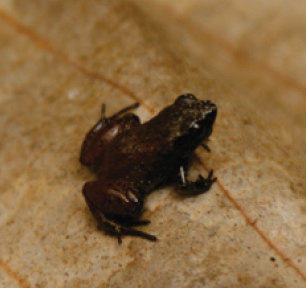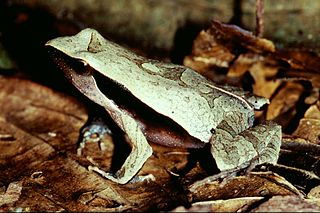
Adelophryne gutturosa is a species of frogs in the family Eleutherodactylidae. It is found on the Guiana Shield from eastern Venezuela through Guyana to French Guiana and adjacent Brazil (Amapá), possibly extending to Suriname. Its type locality is Mount Roraima. Its local Spanish name is ranita guturosa.

Cycloramphus is a genus of frogs in the family Cycloramphidae. The genus is endemic to the southeastern Brazil. They are sometimes known as the button frogs.
Cycloramphus dubius is a species of frog in the family Cycloramphidae. It is endemic to the state of São Paulo, Brazil. Common name São Paulo button frog has been coined for it.
Cycloramphus duseni is a species of frog in the family Cycloramphidae. It is endemic to southern Brazil and only known from its type series collected in 1911 from near Casa Ypiranga along the Curitiba–Paranaguá railway, in the Serra do Mar, Paraná state. Prior to naming of Cycloramphus izecksohni in 1983, it was confused with this species. The specific name duseni honors Per Dusén, Swedish naturalist who collected the type series. Common name Ypiranga button frog has been coined for this species.

Cycloramphus eleutherodactylus is a species of frog in the family Cycloramphidae. It is endemic to the Serra do Mar in southeastern Brazil, including the Serra dos Órgãos, Serra da Mantiqueira, and Serra da Bocaina. Common name Alto button frog has been coined for it.
Cycloramphus fuliginosus is a species of frog in the family Cycloramphidae. It is endemic to southeastern Brazil and known from the Atlantic coastal forest between southeastern Bahia and Rio de Janeiro. Its common name is Tschudi's button frog. The specific name was originally spelled as fulginosus, but the incorrect subsequent spelling fuliginosus by André Marie Constant Duméril and Gabriel Bibron (1841) was followed by later authors and is now preserved on the basis of the "prevailing usage".
Cycloramphus granulosus is a species of frog in the family Cycloramphidae. It is endemic to Brazil. Its natural habitats are subtropical or tropical moist lowland forest and rivers.
Cycloramphus izecksohni is a species of frog in the family Cycloramphidae. It is endemic to southern Brazil and occurs in the Serra do Mar in the states of Santa Catarina, Paraná, and São Paulo. Prior to its description in 1983, it was confused with Cycloramphus duseni. Common name Izecksohn's button frog has been coined for this species.
Cycloramphus mirandaribeiroi is a species of frog in the family Cycloramphidae. It is endemic to Brazil. Its natural habitats are subtropical or tropical moist lowland forests and rivers. Its population is in decline.

Cycloramphus stejnegeri is a species of frog in the family Cycloramphidae. It is endemic to the Serra dos Órgãos in southeastern Brazil. The specific name stejnegeri honors Leonhard Stejneger, a Norwegian–American herpetologist and ornithologist. Common name Stejneger's button frog has been coined for this species.
Eleutherodactylus corona is a species of frog in the family Eleutherodactylidae. It is endemic to the Massif de la Hotte, Haiti. The specific name corona is derived from the Latin word for "crown" and refers to the distinctive tubercles on the top of the head of these frogs. Common name Caye Paul robber frog has been coined for it.

Leptodactylus mystacinus is a species of frog in the family Leptodactylidae. It is found in eastern Bolivia and eastwards to Brazil, Paraguay, and Uruguay and southwards to central Argentina. It is also known as the mustached frog.

Physalaemus olfersii is a species of frog in the family Leptodactylidae. It is endemic to southeastern Brazil and is known from Espírito Santo, southeastern Minas Gerais, and São Paulo states. Records further south refer to Physalaemus lateristriga, which was restored from the synonymy of Physalaemus olfersii in 2010. Common name Atlantic Forest dwarf frog has been proposed for this species.

Proceratophrys bigibbosa is a species of frog in the family Odontophrynidae. It is found in the Misiones Province in the northeastern Argentina and in Rio Grande do Sul and Santa Catarina in southern Brazil; its range might extend into the adjacent Paraguay. Common names Peters' smooth horned frog and Cristina's smooth horned frog have been coined for it.
Odorrana absita is a species of frog in the family Ranidae. It is found in southern Laos and central Vietnam. It was originally described in genus Huia. Its type locality is Xe Sap National Biodiversity Conservation Area in southern Laos.
Leptomantis rufipes is a species of frog in the family Rhacophoridae. It is endemic to Borneo and known from isolated locations in south-central Sarawak and eastern Sabah and central Kalimantan (Indonesia). Common names Malaysian flying frog and red-legged frog have been coined for this species. The specific name rufipes refers to the red webbing of this frog.
Cycloramphus faustoi is a species of frog in the family Cycloramphidae. It is endemic to Ilha dos Alcatrazes, a small island about 35 km off the coast of São Paulo state, Brazil.

Adelophryne patamona is a species of frog in the family Eleutherodactylidae. It is endemic to the Pacaraima Mountains of southwestern Guyana, although it is likely to also occur in the adjacent Roraima state of Brazil. It is most closely related to A. gutturosa.
Leptobrachium mangyanorum is a species of frog in the family Megophryidae. It is endemic to the Philippines and known with certainty only from the island of Mindoro, although it might also occur on the nearby Semirara Island. Even though this species was formally described only in 2010, Edward Harrison Taylor had already in 1920s recognized that it is distinct from Leptobrachium hasseltii, the name used for Philippine Leptobrachium at the time. Common name Mindoro litter frog has been coined for this species.
Leptobrachium masatakasatoi is a species of frog in the family Megophryidae. It is known from its type locality, Phu Pan in Houaphanh Province in northeastern Laos, and from Sơn La Province in northwestern Vietnam. The specific name masatakasatoi honors professor Masataka Sato, Japanese entomologist who collected the holotype. Common name Masatakasato’s eyebrow toad has been proposed for this frog.








